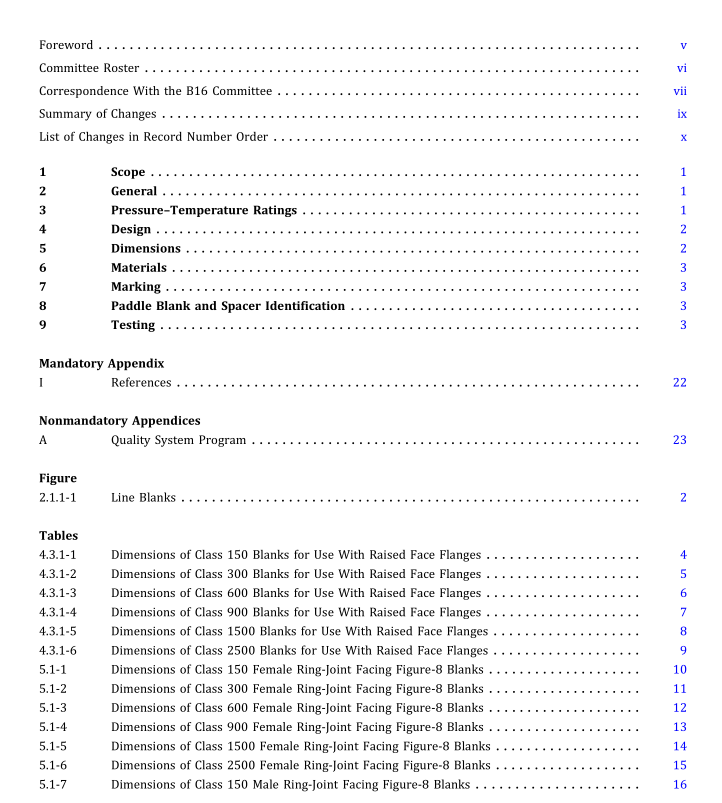ASME B16.48:2020 pdf free download Line Blanks
l scOPE
This Standard covers pressure-temperature ratings,materials, dimensions,tolerances. marking, and testingfor operating line blanks in sizes NPs 1/2through NPS24 for installation between ASME B16.5 flanges in the150,300,600,900,1500, and 2500 pressure classes.2 GENERAL
2.1 Definitions
2.1.1 Figure-8 Blank. A figure-8 blank (also called aspectacle blank) is a pressure-retaining plate with onesolid end and one open end connected with a web ortie bar (see Figure 2.1.1-1).
2.1.2 Paddle Blank. A paddle blank is similar to thesolid end of a figure-8 blank. lt has a plain radialhandle.It is generally used in conjunction with apaddle spacer in large sizes.
2.1.3 Paddle Spacer. A paddle spacer is similar to theopen end of a figure-8 blank.It has a plain radial handle. Itis generally used in conjunction with a paddle blank.2.2 References
Codes, standards, and specifications, containing provi-sions to the extent referenced herein, constitute require-ments of this Standard.These reference documents arelisted in Mandatory Appendix l.
2.3 Quality Systems
Nonmandatory requirements relating to the productmanufacturer’s Quality system Program are describedin Nonmandatory Appendix A.
2.4 Relevant Units
This Standard states values in both Sl (Metric) and u.s.Customary units. These systems of units are to beregarded separately as standard. Within the text, theU.S. Customary units are shown in parentheses. Thevalues stated in each system are not exact equivalents;therefore, it is required that each system of units beused independently of the other. Combining valuesfrom the two systems constitutes nonconformancewith the Standard.
2.5 Convention For determining conformance with this Standard, the convention for fixing significant digits where limits (maximum and minimum values) are specified shall be as defined in ASTM E29. This requires that an observed orcalculatedvalueberoundedofftothenearestunitinthe lastright-hand digitused forexpressingthe limit. Decimal values and tolerances do notimply a particular method of measurement.
2.6 Size NPS, followed by a dimensionless number, is the des- ignation fornominal blanksize. NPS is related to the refer- ence nominal diameter, DN, as defined in ISO 6708. The relationship is typically as follows:
GENERAL NOTE: For NPS ≥ 4, the related DN = 25 multiplied by the NPS number.
2.7 Service Conditions Criteria for selection ofmaterials suitable forparticular fluid service are not within the scope of this Standard.
3 PRESSURE–TEMPERATURE RATINGS
3.1 Pressure Classes Line blanks covered by this Standard are for the following pressure classes: 150, 300, 600, 900, 1500, and 2500 as listed in ASME B16.5.
3.2 Pressure–Temperature Ratings
3.2.1 Ratings. Ratings are the maximum allowable working gage pressure at the temperature shown in ASME B16.5, Tables 2 and 2C for the appropriate material and pressure class. For intermediate temperatures, linear interpolation between temperatures within a pressure class is permitted by ASME B16.5.
3.2.2 System Pressure Testing. Line blanks may be subjected to system tests at a pressure not to exceed 1.5 times the 38°C (100°F) rating rounded off to the next higher 1 bar (25 psi) increment. Testing at any higher pressure is the responsibility of the user, taking into account the requirements of the applicable code or regulation.
3.2.3 Mixed Material Joints. Should either the two flanges or the line blank in a flanged line blank assembly not have the same pressure–temperature rating, the rating of the assembled joint at any temperature shall be the lower of the flange or line blank rating at that temperature. 4 DESIGN 4.1 Handle The handle or web (tie bar) maybe integral or attached to the line blank or spacer. The web and its attachment shall be capable of supporting the weight of the blank or spacerin all orientations withoutpermanentdeformation to the web.
4.2 Edge Preparation In addition to machining, flame, plasma, saw cutting, and press punching are acceptable methods for forming the inside and outside diameters of line blanks. Surfaces shall be free of projections that would interfere with gasket seating.
4.3 Facing
4.3.1 Raised Face Joint Blanks. The gasket-seating surface and dimensions for line blanks used with raised face flanges shall be in accordance with ASME B16.5. A raised face may be specified for these blanks at the option of the purchaser. The height of the raised faces shall be in addition to the thicknesses, t, listed in Tables 4.3.1-1 through 4.3.1-6.
4.3.2 Female Ring-Joint Blanks. Female ring-joint grooves shall be shaped with the groove side wall surfacefinishnotexceeding1.6μm(63 μin.) Raroughness. The finish of the gasket contact faces shall be judged by visual comparison with Ra standards (see ASME B46.1) andnotbyinstruments havingstylustracers andelectron- ic amplification.
4.3.3 Male Ring-JointBlanks. The gasketshape (ring) formale ring-jointblanks shall notexceed1.6 μm (63 μin.) Ra roughness. The finish ofthe gasket contact faces shall be judged by visual comparison with Ra standards (see ASME B46.1) and not by instruments having stylus tracers and electronic amplification.
5 DIMENSIONS
5.1 General Dimensions shall be in accordance with Tables
4.3.1-1 through 4.3.1-6 and 5.1–1 through 5.1-12.
5.2 Tolerances
5.2.1 Facing Tolerances. Tolerances for facings shall be in accordance with ASME B16.5.
ASME B16.48:2020 pdf free download
